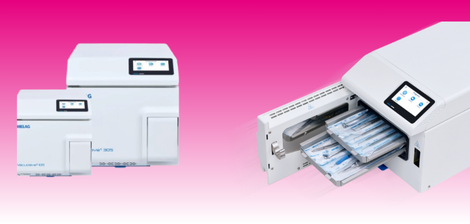What features do you need in a dental hand piece?
With its ubiquitous presence in the surgery, a dental handpiece is a key essential in any practitioner’s armamentarium. Electric or air turbine, high speed, slow speed or speciality, handpieces are used for a multitude of treatments – and clinicians also have the option to modify a basic handpiece for a variety of procedures.
However, there are some key factors that should always be considered before selecting a handpiece.
1. Peace of mind.
The first consideration of any piece of equipment used in surgery is its provenance. With the internet now the fastest and most popular route to purchasing dental appliances, due diligence is essential in helping to establish the trustworthiness of any supplier. Much like dental practices, dental businesses build customer confidence through transparency, so they should be more than happy to answer those FAQs, such as:
- Is the device CE certified to show compliance with safety requirements?
- Is it from an ISO 13485-certified manufacturer of dental handpieces?
- Is it from a UK supplier?
- Does it come with a warranty?
2. Type of handpiece.
If you haven’t already settled on what suits your clinical practice, then the first decision to make is whether to choose an air turbine or electric handpiece. The profession is transitioning towards electric of late, but air turbine handpieces have their place in surgery. Driven by compressed air to generate rotation, air driven handpieces are lightweight, small but so too is their torque and have a tendency to slow down when friction is applied. They come with a high level of noise. The advantages of electric handpieces are better torque and speed control, which ensures precision. When using more aggressive burs, they can deliver an excellent cutting efficiency for removing old restorations or prepping teeth for prosthetics. And because the handpiece held in one place with minimum movement, the small head size offers clarity of vision and easier access to children’s mouths and/or patients who cannot open their mouths wide, and for posterior work. However, electric handpieces come at a higher cost due to the additional investment needed in the motor and controls. They are also a lot heavier. High speed handpieces are one-piece units with angled heads and water sprays and used for removal of enamel and tissue. Slow speed handpieces are ideal for removal of soft decay, cavity preparation, prophylaxis, polishing, trimming and endodontic and implant work. Worth noting is that an electric handpiece can perform the same functions that both an air-driven high-speed and separate low-speed unit can.Contra-angle handpieces are ideal for precise cutting, removing decay polishing restorations, adjusting crowns and bridges. Straight handpieces are ideal for trimming or oral surgery. Other considerations include light intensity.
3. Strength and longevity.
Do compare the handpieces that are on the market and will you’re your clinical practice. Take a look at the reviews to ascertain their life expectancy. Ask colleagues what they recommend and where to source the products. Whether a multi-practice or single-handed practitioner, dentists need to know they can rely on their equipment to deliver treatment safely and effectively without interruptions caused by frequent breakages or the need for replacements.
4. Comfort and facility.
Personal preference in clinical practice is inevitably a key driver in the choices made about the appliances used. Whilst evidence-based studies can influence practitioners in the choices they make, ultimately it is how it feels to handle and what it will be used for that are very often the factors that secure a final decision. Ergonomics and weight are important considerations in a profession beset by occupational health issues, such as repetitive strain injury and musculoskeletal disorders often caused by long periods of time in awkward positions using tools daily in repeated motions. Any handpiece that is slim, lightweight easy to use and reduces fatigue in lengthy procedures will tick boxes. Dental shows and exhibitions offer clinicians fantastic opportunities to try before they buy, and with face-to-face contact now being phased back into our lives, it may be worth a trek to an event to check out the latest advancements in handpiece technology.

5. Kind to patients.
Dentistry is beset by a reputation for pain, so patients expect practices to have invested in equipment that makes their dental journey a pleasant one. One of the key triggers of fear is the sound within a surgery and a noisy handpiece can contribute to this. A good quality handpiece will perform excellently, not only reducing the time spent in the chair during any procedure but will also perform less noisily. Opting for slow speed electric handpieces operates with lower decibels therefore protecting the more fearful patients from any off-putting noise. Plus, the high torque of an electric handpieces means it operates faster and with precision than air turbines, thereby limiting appointment times.
6. Easy to use.
Function is a key driver in the delivery of good dentistry. Efficiency and quality is therefore an important factor when choosing equipment, with ease of use essential. A handpiece that is easy to install as well as operate rates highly with dentists. Handpieces that deliver reliability and consistency also help clinicians make the best choices.
7. Driven by new technology and research.
As we know, dentistry is a fast-paced profession with digitalisation and technology taking it to new heights and having a hugely positive impact on everyday practice. The next generation of handpieces offers practitioners maintenance-free and self-lubricating options, as well as high performance choices. Clinicians should read around the topic and familiarise themselves with what’s hot in the world of handpieces and apply the principles of any new innovations to their own practice to ensure it will enhance their business and their clinical delivery before making any investment.
8. Right tool for the job.
When your preference is an electric motor high-speed handpiece or an air turbine handpiece, knowledge and application are everything. So, what type of procedure will you use it for? There is a broad spectrum of brands and types of handpieces in the market, some models and styles more suited to specific tasks than others. Specialist handpieces can suit specific clinical procedures, including:
- Surgical
- Periodontics
- Endodontic
- Prophylaxis
- Air abrasion
- Implantology
- Scaling
- Caries detection
It is worth browsing a supplier’s online selection to discover what handpiece best suits need.
9. Decontamination friendly.
A handpiece is inevitably put through its pace over time with contamination by saliva, blood and tissue. This means that all handpiece components used intraorally need to be resilient to the safety and infection controls that prevent contamination and cross infection. Some handpieces inevitably come with their own set of challenges with regards cleaning and disinfection due to their water and air channels, and practitioners should be assured they are robust enough to undergo the tough cleaning protocols required whilst continuing to deliver high performance care. Plus, a well maintained and clean handpiece will reduce unnecessary expenditure.
10. After-sales service.
On-going support is a vital part of your purchase. It may not seem relevant at the time of initial purchase, but even if you invest is in a handpiece built to last a long time, it still needs professional care and attention and servicing to ensure that longevity. If the supplier also offers a repair service, then check if it includes the model you are buying and ask about turnaround times. When purchasing, don’t forget to ask about its warranty. And remember, good quality and well-maintained handpieces can help a practice minimise unnecessary expenditure, so choosing a supplier that also has an award-winning handpiece service and repair centre is recommended.



